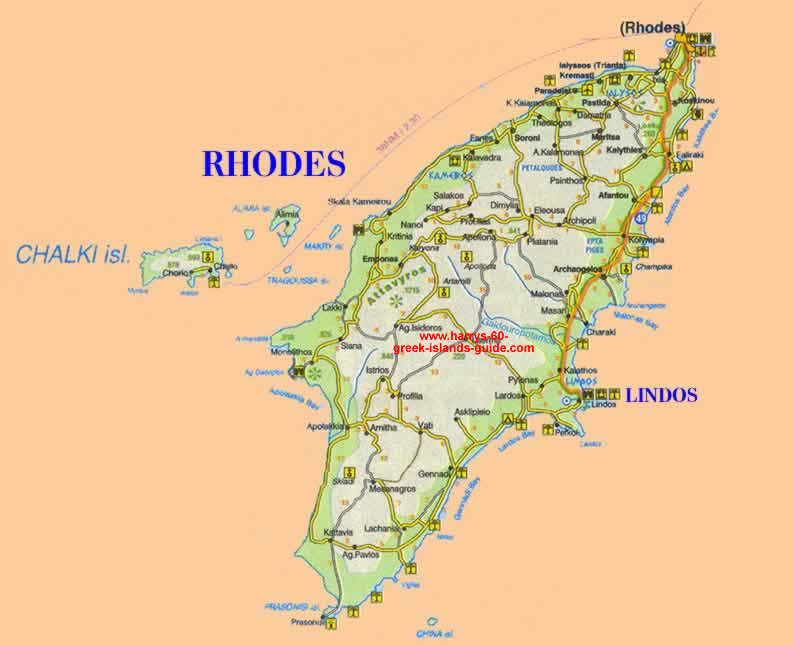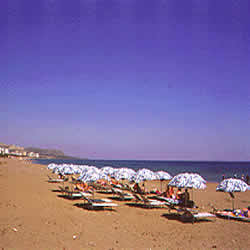 Map & Synopsis: Greek Island of Rhodes (Dodecanese)
Map & Synopsis: Greek Island of Rhodes (Dodecanese)
Rhodes has half of the population of the Dodecanese, with some 110,000 inhabitants, around 60,000 of them in Rhodes Town, its main city.
It is the most visited island in Greece after Crete, with some million tourists annually.
It is only 11 km (6.9 miles) from the coast of Asia Minor, from which it is separated by the Strait of Marmara.
The island is mostly fertile, with citrus, olives, figs, pistachios, and with many trees, herbs, and a wide variety of fauna. The island is known for its 300 sunny days per year, and its fine sandy beaches on the east side, the west coast getting more wind.
Tourism is concentrated in the upper third of the island. There are some huge resorts, such as Faliraki, with some of the worst aspects of mass tourism, though there are also long stretches of undeveloped beach .
 The island has monasteries, mountains,
vineyards, the beautiful town of Lindos with its 15th to 17th century houses and its acropolis, though much
impacted by tourism during the past decades. The acropolis of Lindos is a major tourist attraction in
Rhodes, excavated during the early 20th century and badly restored by the Italians, with a Greek restoration
program now in progress.
The island has monasteries, mountains,
vineyards, the beautiful town of Lindos with its 15th to 17th century houses and its acropolis, though much
impacted by tourism during the past decades. The acropolis of Lindos is a major tourist attraction in
Rhodes, excavated during the early 20th century and badly restored by the Italians, with a Greek restoration
program now in progress.
The package resort of Pefkos is to the south of Lindos; the village of Lardos to its west. The 9th century monastery of Moni Thari is near Laerma (near the center of the island), with 12th century frescoes; the medieval village of Asklipio (named for the Greek god of healing), is on a hill beneath the ruins of a Crusader castle; the Monastery of Metamorfosi church dates from the 11th century AD, with 15th century frescoes.
Yennadhi, on the southeast coast is a farming village with a sand and pebble beach, with watersports; Aghios Yiorghos also has watersports. Foreigners have restored many houses in Lachania, slightly inland and another 10 km south of Yennadhi; there are some rooms for rent here. Plimiri, at Cape Vigla, down at the southeast tip of Rhodes, has a new marina and a fish farm, but also some good unspoiled beaches, one of which is one of the last places in the Dodecanese where loggerhead turtled nest, an area which has hopefully been given official protection.
 Cape Prassonisi at the southern tip of the island is a big
wind surfing area (though wheat and barley are also cultivated there). Ruins of a 6th to 7th century BC
settlement were discovered at Vroulia nearby; Mesanagros is a hill village with nearby ruins of a 5th century
basilika, with remnants of floor mosaics and a 13th century chapel; the 13th century monastery of Moni
Skiadhi is in the same area, with a festival on the 7th and 8th of September.
Cape Prassonisi at the southern tip of the island is a big
wind surfing area (though wheat and barley are also cultivated there). Ruins of a 6th to 7th century BC
settlement were discovered at Vroulia nearby; Mesanagros is a hill village with nearby ruins of a 5th century
basilika, with remnants of floor mosaics and a 13th century chapel; the 13th century monastery of Moni
Skiadhi is in the same area, with a festival on the 7th and 8th of September.
The southwest coast gets a lot of wind, and also some garbage (and hence few tourists); Apolakia, to the north is famed for its watermelons and wedding feasts, and also has some rooms, tavernas and kafenia (cafes). Monolithos village has a 15th century chapel (Aghios Yiorghos) with a spiral staircase running up it with spectacular views from the top; the bay of Fourni is far below, with both sand and gravel beaches, and strong currents that require some caution on the part of swimmers.
Early Christian cave dwelling are located around the headland; the town has some rooms and tavernas. The second highest peak of the island, with dense forest on its lower slopes, is Mt. Akramytis (825 meters/2706 feet), which has been proposed as a nature reserve. The attractive village of Siana is on this mountain, with great coastal views, and is known for its wild pine and sage honey, and its suma (local spirit similar to raki or grappa).
 18th century frescoes are found in the church of Aghios
Panteleimon. Embonas village is known for its wine, olives, tobacco, dancing and festivals, and some of the
locals still wear traditional costume. There are wine cooperatives with tasting rooms here, one of their
acclaimed white wines made from an indigenous grape that grows on Rhodhes highest peak, Mt. Atavyros (1215
meters/nearly 3000 feet), which is a three hour climb from Embonas. A less touristic town nearby is Aghios
Isodhoros, with vineyards and tavernas; the village of Kritinia is also quite appealing, with a folklore
museum.
18th century frescoes are found in the church of Aghios
Panteleimon. Embonas village is known for its wine, olives, tobacco, dancing and festivals, and some of the
locals still wear traditional costume. There are wine cooperatives with tasting rooms here, one of their
acclaimed white wines made from an indigenous grape that grows on Rhodhes highest peak, Mt. Atavyros (1215
meters/nearly 3000 feet), which is a three hour climb from Embonas. A less touristic town nearby is Aghios
Isodhoros, with vineyards and tavernas; the village of Kritinia is also quite appealing, with a folklore
museum.
To the north is Kamiros Skala, ancient port of Kameiros, one of the three Dorian cities of ancient Rhodhes, which is now a fishing village and ferry link to Halki, topped by one of the most impressive of the Knights' castles. There's a big festival from 15 -23 August at Kremasti, with some fine Dodecanesian folk dancing. Other sites on the far northwest coast include the monastery Our Lady of Filermos, Ancient Ialysssos, the subterranean frescoed chapel of Ai Yeorghis Hostos.
Ixia is full of huge hotels. Petaloudhes (misnamed 'Butterfly Valley', since there are Jersey moths there) is found inland, with the valley itself quite beautiful aside from these rather harassed creatures. Other inland sights include the Monastery of Panaghis Kalopetra (1782), the Monastery of Aghios Soulas on the road to Soroni, where there is a big festival on the 30th of July with donkey races and folk dancing, the village of Psinthos, and the thickly forested mountain of Profitis Ilias with some villages, a Byzantine church, and another monastery around and on its slopes.